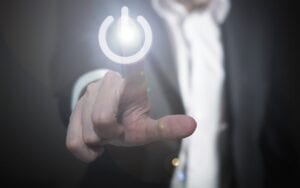You can find some absolutely free, quick and easy wins that will improve your sustainability and reduce your environmental impact by encouraging minor changes to your behavior and the behavior of those around you. However, you need to introduce these ideas gently by motivating people to change through education, communication, and appeal to their values. You probably know most of these sustainable ideas; but if people are not doing them, you need to ask yourself “why?”
Let’s look at the zero-cost ways you can reduce energy:
Lights on or off? Turn off incandescent or halogen bulbs when not needed, because 90% of their energy is wasted in generating heat rather than light.[1] Fluorescent tube lights [2] and CFL task lights don’t generate as much heat and their life is slightly shortened by frequent turning on and off, so the EPA gives a rule of thumb of 15 minutes. If you are leaving a room for a bathroom run, leave the fluorescent lights on. If going out to lunch or a meeting, turn them off. LED lights are great,  if you have them, because they turn on instantly and not affected by frequent switching on and off, so they will always save you a small amount when not in use.
if you have them, because they turn on instantly and not affected by frequent switching on and off, so they will always save you a small amount when not in use.
Tip. Signs and labels encouraging folks to turn off lights (or other green reminders) do not work for more than a few days. They become “part of the landscape.” You might be more successful if you appeal to people’s values. Financial people care about saving the organization money; traditional folks hate wasting anything; climate change activists are out to save the planet. You can add appropriate messages to various forms of communication: posters, emails, social media, and other ideas, depending on your organizations’ communication channels. Once your message resonates, people will remember to do what is “the right thing” to them. You can use this tip for any of the behavior changes in this chapter.
Computers. The Department of Energy guidelines [3] suggest turning off computers if they’re not being used for more than two hours and let the monitors enter sleep mode automatically after a set time. However, many folks resist turning off their computers during the day or even overnight because it takes more time to start up a computer than they want to wait. For those folks, a great alternative is the computer’s sleep mode [4] (one of the power on/off options). Sleep mode saves 90% of the energy used when a computer is on and the computers turn on in two seconds vs. more than a minute. One sustainability professor said:
I used to leave my computer on all the time, even though I knew better, because my old computer took forever to turn back on each morning. One of my interns did an experiment, measuring the energy used by my computer (1) left on 24 hours, (2) turned off at night, and (3) put in sleep mode at night. My intern calculated that the sleep mode saved 90% over leaving it on (which I’ve since confirmed with further research). Now I feel better because I’ve reduced my energy use significantly without adding to my aggravation.
Thermostats. What is your most comfortable temperature? Do you freeze in the summer when you go into a building? Have to wear a sweater at work? If you have control over the thermostat in your area, try setting it at an energy-saving, but comfortable, setting. For every degree you turn a thermostat up or down for the day (i.e., 8 hours), your organization can save 1% of the energy used. The Department of Energy suggests turning the air conditioning to 78 degrees in hot months and the heater to 68 degrees in cold months, but everyone’s tolerance is different. If you don’t want a massive rebellion, it’s best to leave these decisions to the primary occupants, but you can appeal to their values to adjust temperature in their room, just as you did with lights.
One last thought on thermostats: you can also change the thermostat up to 10 degrees when you leave for the day to save the organization up to 10%!
Vampire loads. A number of electrical and electronic devices continue to consume electricity even if they are not on.[5] Computers, monitors, printers, copiers, phone chargers, CFL light bulbs, coffee machines, and microwaves all waste energy when left plugged in.[6] Unplugging them when not in use would save energy, but it’s not always easy to get to the plugs, hidden as they are behind desks, bookcases, or equipment. Help yourself and others by making it easier to reach those plugs.
You can do any or all of these ideas without having to spend a penny! There are many other ideas that are very low cost, but those are the topic of another blog…
For many more ideas like these, take a look at Green Projects: Balancing People, Planet, and Profit.
References
[1] Energy.gov. When to turn out your lights. Retrieved from: https://www.energy.gov/energysaver/save-electricity-and-fuel/lighting-choices-save-you-money/when-turn-your-lights
[2] Lighting Design Lab. Should I turn off fluorescent light when leaving a room? Retrieved from: https://www.lightingdesignlab.com/resources/articles/articles-lighting-fundamentals/should-i-turn-fluorescent-lights-when-leaving-room
[3] Energy.gov. Energy Efficient Computers, Home Office Equipment, and Electronics. Retrieved from: https://www.energy.gov/energysaver/appliances-and-electronics/energy-efficient-computers-home-office-equipment-and
[4] Cross, J. Why you should use sleep mode. PC World. Retrieved from: https://www.pcworld.com/article/169941/Why_You_Should_Use_Sleep_Mode.html.
[5] San Diego County Library. Vampire Loads Waste Energy. Retrieved from: http://www.sdcl.org/reusable_components/images/dgs/Documents/Energy_Vampire_Loads.pdf
[6] Miller, G. (2019). Stop Wasting Money on Electricity! Your Guide to Identifying & Unplugging Standby Power Appliances. Retrieved from: https://20somethingfinance.com/electrical-leaking-standby-appliance-list/
